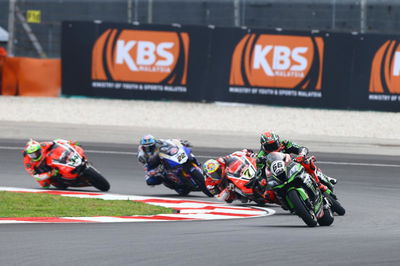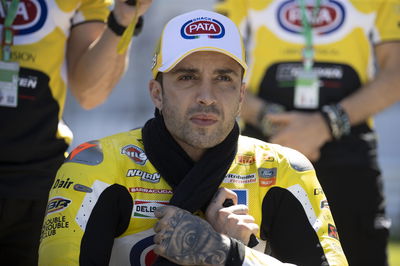Turning the corner: Who does what in WSBK

What does a British Superbike title contender do on his weekend off?
If you're Michael Laverty, you fly halfway around the world to assist brother-in-law Chaz Davies at the Sepang World Superbike round.
The racing Laverty brothers (Michael, Eugene and John) are renowned for their ability to 'spot' trackside; studying the behaviour of each bike and rider to help - in this case - Chaz.
In MotoGP, Valentino Rossi now has Luca Cadalora to provide such information, while Jorge Lorenzo has long counted on the trackside advice of another former racer, Wilco Zeelenberg.
Just before the wet second race at Sepang, Crash.net asked Michael if he could explain the differences between the riding techniques in WSBK this season...
 |
| WSBK race one action at Sepang. |
Michael, you've been watching trackside, what have been your main impressions?
Michael Laverty:
This is my third World Superbike round this year. I've done Aragon, Assen and now Sepang. There's definitely a common trend when you watch the Kawasakis in comparison with the Ducatis or Yamahas.
The Ducati is a twin-cylinder and the Yamaha effectively works like that with its firing order. So they are more corner-speed type of bikes. They don't have the 'point-and-squirt' style of the Kawasaki. The Honda has a little bit less power than the new Kawasaki off the turns, so is also a little more flowing.
In terms of individual riding styles, Tom Sykes is probably the furthest from the others. He brakes really deep, has the slowest mid-corner speed and then accelerates really hard. If you time him from 100 metres before the corner until 100 metres after, it's the same or faster than the others, but done in such a different way. As we saw in race one, it's really effective for him.
Tom's team-mate Johnny Rea rides more conventionally; late on the brakes, but carries a little bit more mid-corner speed and then tries to accelerate on the side of the tyre. More so than Tom.
 |
| Tom Sykes at Sepang. |
Does Tom get the maximum lean angle, to get the turning done in a shorter space of time before he gets on the power?
Michael Laverty:
It's funny, that's one thing I've noticed a lot about the Kawasaki: It turns very well without a massive lean angle. So when you watch Chaz on the Ducati, for example, he carries a lot of speed on the front tyre and a lot of lean angle to get the bike to turn at that speed.
Whereas to do that same turning arc the Kawasaki doesn't need to be leant over as far. It's possibly as much as 15-20 degrees difference. It's huge!
You really notice it in the wet, like at Assen, or on a damp track. I don't know exactly if it's because they turn using the rear of the bike more, but from track side it looks like maybe they have more weight to the rear and it just kind of hooks them around the turn.
The Ducati and most other bikes have a normal turning arc, where they load the front and turn on the front tyre. The Kawasaki looks very neutral; in the middle of the corner both wheels are loaded, but it's still turning. It's funny when you watch it. It seems to be a strength for them at certain times, but could also be a weakness. It's a new bike for this year so they are still learning.
I'd definitely say that's probably the most noticeable difference compared with all the other bikes.
 |
| Chaz Davies and Jonathan Rea on the brakes at Phillip Island |
Looking just at braking, who would you say is the strongest?
Michael Laverty:
I'd say the strongest out there is Chaz and the next would be Tom Sykes. They are the only two that are visibly deeper, the rest all kind of hit the same braking marker.
Chaz brakes very late and carries a lot of corner speed, so he tips it in with a lot of entry speed. Whereas Tom brakes late and then really stops it, to a slower mid-corner speed. Two very different ways, but they both hit the anchors at the latest possible moment.
Johnny is a consistently strong braker, but he doesn't out-brake himself very often. He's a very smooth rider, looking from the side of the track.
A lot of the braking is to do with the electronics as well as chassis set-up. Everyone in World Superbike has got auto-blip backshifts and electronics, so you hear them going back though the gears and it keeps everything in-line.
 |
| Michael Laverty and Cal Crutchlow do the leg dangle during the 2014 MotoGP season. |
The leg dangle - do you do it? Who does it in World Superbike and what is the benefit?
Michael Laverty:
It's not as common as in MotoGP, but there are still maybe 10-11 people doing it on a consistent basis in World Superbike. In MotoGP the tyres and chassis are slightly more rigid. That means they can brake a bit later because the bike stays more stable and then the leg dangle has more effect.
I personally do it, but only into left-handers and not into rights because I like to have my foot on the rear brake. I use the leg dangle to balance the bike and adjust the trajectory while the bike is still upright. Just moving the leg off adjusts the weight and moves you a few inches to one side.
Sometimes it's also a panic button. Whenever you are in a little bit deep you just dangle the leg, or maybe even touch your foot down on the track. Hanging your leg out also increases the wind resistance, helping you stop as a kind of air brake.
So there's various reasons for it and it is a tool that's available to the riders. I know some purists don't like it and someone like Jorge Lorenzo never does it. But Jorge's not a late braker. He brakes early, is super smooth and enters the corner with unreal speed. I guess it's more for late brakers, or guys that are getting loose in the braking area.
 |
| Jonathan Rea, Tom Sykes and Chaz Davies in Thailand. |
Moving on to the mid-corner, you mentioned Sykes' technique, is he the slowest of the top riders in that area?
Michael Laverty:
For sure. It's funny to say that about a world champion, but in the mid-part of the turn he is the slowest guy - but, as I say, his entry speed and exit is so fast. So there is a reason for it. He rides in that stop-and-go style and it really works for him.
In the faster corners it's less evident that Tom is slowing it down because he has to carry the speed, but he still accelerates very hard on the exit. Tom makes a 'V' shape through of the most corners. The rest of the guys have a smoother arc and flow through the turn a bit more.
When I've seen Chaz confident at Aragon and Assen I would say his mid-turn is just that few mph up on Johnny. Someone like Nicky is more conventional; he's not point-and-squirt, he's not relying on super corner speed, he's doing a bit of everything.
It's a bit like Valentino Rossi. Rossi does everything to a very high level. I've always watched Valentino; I was curious to see how the best in the world - or the best of all-time possibly - does it.
Seeing Valentino here in the pre-season last year, he's not got one particular area where you'd say he's doing something incredibly fast. You watch Jorge and can see he tips in with super corner speed and loads both wheels together. Marquez enters very fast, a lot of brakes and throws it in. It looks very rash, loose and fast.
Valentino just looks smooth: He brakes late, but not super-late. He turns in fast, but not super-fast. He's just doing everything at a very, very high level and pieces it all together. I think that's what makes Valentino so good, on so many different bikes, over such a long period of time.
It's always interesting to see how different riders get around a racetrack. The tyres and chassis mean a different riding style in WSBK than in MotoGP, but the riding level isn't actually massively different.
 |
| Jonathan Rea at Sepang. |
How about getting on the throttle and corner exit?
Michael Laverty:
Electronics play a big part in that. The Kawasaki controls two cylinders independently of the other two. So it sounds almost like a two-cylinder on the first pick-up of the throttle. Very soft. In the wet, whenever you hear Jonathan and Tom on the side of the tyre, it sounds really docile. Like a sewing machine! For an inline four-cylinder, which is a real powerhouse when they open it up, it's surprising to hear that softness down low.
From the side of the track, I could hear BMW trying to emulate that a bit with their bike. It's not as smooth yet as the Kawasaki, but it's improving race-by-race. Reiterberger was noticeably really strong here in Friday practice and it sounds a lot more docile down low. A lot more useable.
The Ducati is a funny beast because it's twin-cylinder, so if they reduce the power by cutting one cylinder it's quite an aggressive cut. Because of that they don't use as much electronics and rely on their chassis and better power management out of the engine.
They have good acceleration and drive, but do it in a different way to the Kawasaki, which has more cylinders to play with and can bring it right down with the electronics.
The top priority is to get onto the fat part of the tyre and deliver 200-plus bhp down onto the track. It's all about getting off the tyre edge, because when you are at 50-60 degrees of lean angle you can't put any power through the tyre.
Those who can just hook it around on that last bit of lean and get it upright sooner are the faster guys. You can see that. And again it's the front three - Chaz, Tom and Johnny - who do it on a more consistent basis.
The rest of the guys are all trying to work towards that level, but are just that little bit off. It's very small. Sometimes it's hard to see because they all look pretty fast in the longer corners. It seems to be the exit of the tighter stuff where you really see the differences.
Crash.net:
That's really interesting Michael, thanks.
Michael Laverty:
You're welcome.
 |
| Michael Laverty's day job: Winning BSB races for Tyco BMW. |











